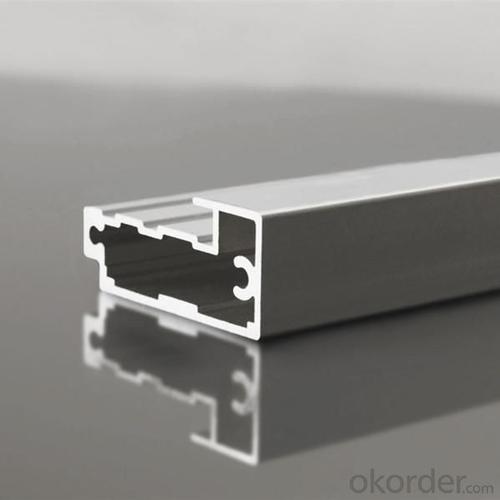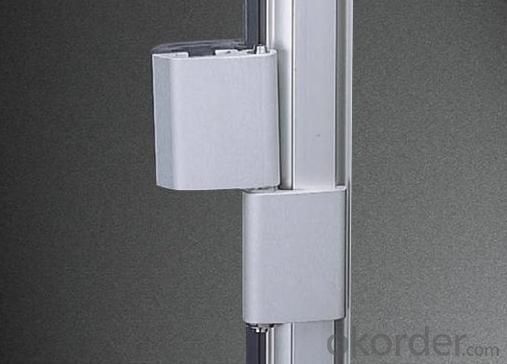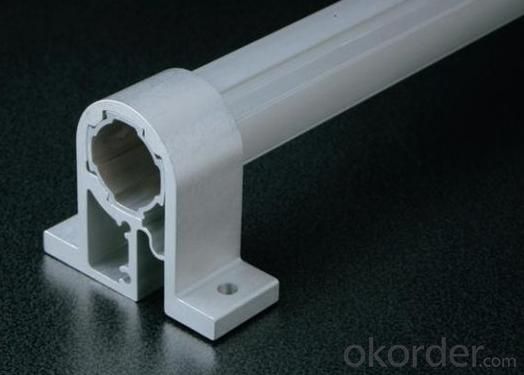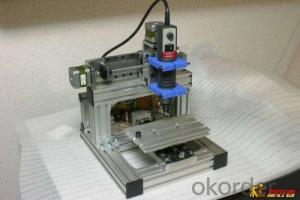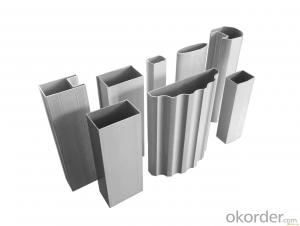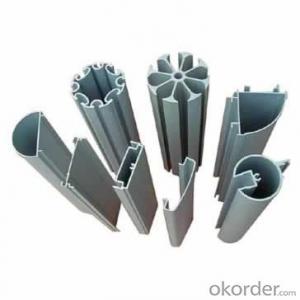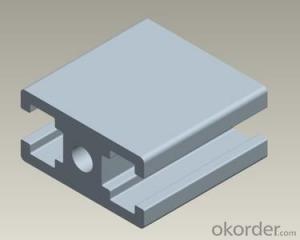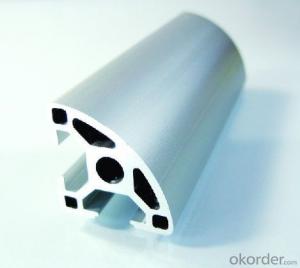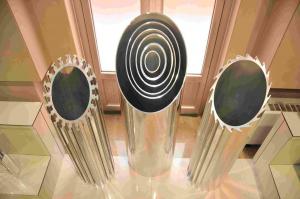Aluminum Extrusion Profiles 6060-T5 UK
- Loading Port:
- ShenZhen
- Payment Terms:
- TT or LC
- Min Order Qty:
- 10MT m.t.
- Supply Capability:
- 1000 Tons Per Month m.t./month
OKorder Service Pledge
OKorder Financial Service
You Might Also Like
1 Specifications of Aluminum Profiles 6060
Alloy Number | 6063 6061 6060 and different aluminium alloy |
Temper | T4 T5 T6 or other special status |
Surface available | Mill finish, Anodized, Powder Coating, Wooden transfering, electrophoresis, heat insulation, PVDF, and deep processing |
Thickness: | >0.8mm |
Width: | <300mm |
Standard | GB5237.1-2008 |
Special Specification is available on customer’s requirement
2 Usage/Applications ofAluminum Profiles 6060
Aluminium Profiles are widely used in construction(windows & doors,curtain wall), decoration ( flooring and tiling, kitchen) and industry ( heat sink ).
CNBM produces aluminum profiles which meets the national standard GB5237.1-2008. Our strong quality control term bring you the most-qualified products. And with state-of-the-art equipment, and the state owned company background, we have to say, you will understand why there are so many company choose CNBM to be their supplier.
3 Packaging & Delivery of Aluminum Profiles 6060
Packaging:Seaworthy package, bubble plastic bag inside, anti-moisture paper wrapped outside, covered with cartons, on wooden pallets, in containers.
Shipment:the goods will be delivered in 15-30days after getting the buyer's payment.
4 Production Flow of Aluminum Profiles 6060
aluminium ingot & alloy→melting and casting→extrusion→powder coating→pouring rubber for heat insulation→checkout→packing→PVDF coating\anodizing\electrophoresis→put in products warehouse.
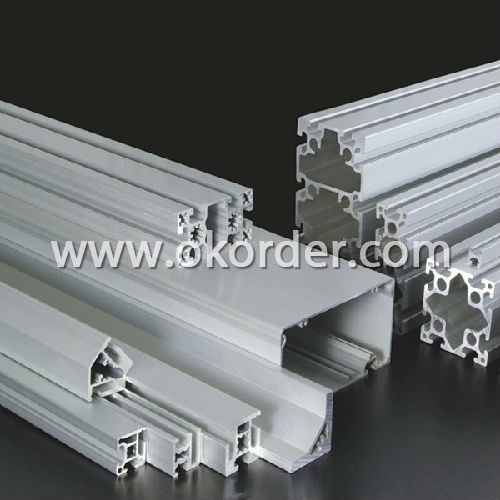
- Q: What are the advantages of using aluminum profiles in the renewable energy sector?
- There are several advantages of using aluminum profiles in the renewable energy sector. Firstly, aluminum profiles are lightweight yet strong, making them ideal for constructing solar panel frames, wind turbine components, and other renewable energy infrastructure. Their strength-to-weight ratio allows for easy transportation and installation, reducing costs and improving efficiency. Secondly, aluminum profiles are highly corrosion-resistant, making them suitable for outdoor applications in harsh environments. This durability ensures that the renewable energy infrastructure remains stable and functional for extended periods, even in coastal or corrosive environments. Additionally, aluminum profiles offer excellent thermal conductivity, which is crucial for effective heat dissipation in renewable energy systems. This property allows for efficient cooling of solar panels, wind turbine generators, and other components, thus enhancing their performance and lifespan. Furthermore, aluminum is a sustainable material that can be easily recycled. As the renewable energy sector focuses on promoting sustainability, using aluminum profiles aligns with the industry's goals. Aluminum can be recycled repeatedly without losing its properties, reducing the demand for primary aluminum production and minimizing the carbon footprint of renewable energy projects. Lastly, aluminum profiles offer design flexibility and versatility. They can be easily customized and fabricated into various shapes and sizes, allowing for efficient integration into different renewable energy applications. This adaptability enables engineers and designers to optimize the use of aluminum profiles, resulting in improved energy efficiency and overall system performance. In conclusion, the advantages of using aluminum profiles in the renewable energy sector include their lightweight yet strong nature, corrosion resistance, thermal conductivity, sustainability, and design flexibility. By incorporating aluminum profiles into renewable energy infrastructure, we can enhance the efficiency, durability, and environmental sustainability of the sector.
- Q: This question asks about the various types of insulation panels that utilize aluminum profiles in their construction.
- <p>Insulation panels made from aluminum profiles come in several types, each with specific characteristics and applications. These include: 1. Sandwich Panels, which consist of two aluminum sheets with a core material like polyurethane, rockwool, or polystyrene. 2. Composite Panels, which combine aluminum with other materials for enhanced properties. 3. Structural Insulated Panels (SIPs), used in construction for their thermal efficiency and strength. 4. Cold Storage Panels, designed to maintain low temperatures in refrigeration units. 5. Acoustic Insulation Panels, which reduce noise transfer. Each type is chosen based on the required thermal, acoustic, and structural performance.</p>
- Q: What are the thermal properties of aluminum profiles?
- Aluminum profiles have excellent thermal properties. They have high thermal conductivity, allowing heat to be transferred quickly and efficiently. They also have a low coefficient of thermal expansion, meaning they can withstand temperature changes without significant distortion or damage. Additionally, aluminum profiles have good heat dissipation capabilities, making them suitable for applications requiring heat management, such as in electronic devices or heat sinks.
- Q: What are the different tolerance levels for aluminum profiles?
- The specific requirements and applications can cause the tolerance levels for aluminum profiles to differ. Various industries, including automotive, aerospace, and construction, typically demand aluminum profiles with tight tolerance levels. Aluminum profiles commonly have dimensional tolerances, straightness tolerances, and surface finish tolerances. The dimensional tolerances ensure that the profile meets the required measurements and fits properly in its intended application. Typically, these tolerances are specified in millimeters or inches. Straightness tolerances guarantee that the aluminum profile does not deviate from a perfectly straight line. This is vital for maintaining structural integrity and accurate assembly. Surface finish tolerances determine the acceptable level of imperfections on the profile's surface, such as scratches, indentations, or roughness. These tolerances are often specified in terms of roughness average (Ra) or surface quality codes, like anodized or powder-coated finishes. It is crucial to consider that the tolerance levels for aluminum profiles can vary depending on factors such as the manufacturing process, intended application, and industry standards. Therefore, it is essential to consult relevant specifications, industry standards, or the supplier's guidelines to determine the precise tolerance levels for a specific aluminum profile.
- Q: How do aluminum profiles contribute to the reduction of noise pollution?
- Aluminum profiles contribute to the reduction of noise pollution in several ways. Firstly, aluminum is a lightweight material that can be used to construct windows and doors with excellent sound insulation properties. These profiles can effectively block and absorb sound waves, preventing outside noise from entering indoor spaces and vice versa. Moreover, aluminum profiles are highly durable and can maintain their structural integrity over time. This durability ensures that the sound insulation properties of the profiles remain effective for an extended period. Unlike other materials, aluminum does not warp or degrade easily, allowing it to consistently provide a barrier against noise pollution. Additionally, aluminum profiles can be designed with special features to enhance their noise reduction capabilities. For instance, manufacturers can incorporate rubber or foam seals into the profiles, which further minimize sound transmission by creating an airtight seal when the windows or doors are closed. These seals effectively block out external noise, creating a quieter and more peaceful indoor environment. Furthermore, aluminum profiles can be customized to fit specific requirements and noise reduction needs. They can be designed with multiple layers of glass, each with different thicknesses and acoustic properties, to provide even higher levels of sound insulation. This customization allows for the creation of tailored solutions to address different levels of noise pollution, making aluminum profiles a versatile option for noise reduction. In summary, aluminum profiles contribute to the reduction of noise pollution through their lightweight yet durable construction, sound insulation properties, and customization options. By blocking and absorbing sound waves, these profiles create a quieter indoor environment, enhancing the overall comfort and quality of life for individuals in both residential and commercial spaces.
- Q: This question asks for methods to prevent aluminum profiles from rusting during the transportation process.
- <p>To prevent rusting of aluminum profiles during transportation, ensure proper packaging with moisture-resistant materials. Use protective films or covers to shield the profiles from direct contact with moisture and humidity. Maintain a controlled environment in the transport vehicle, avoiding high humidity and condensation. Regularly inspect the profiles for any signs of moisture or damage and address them promptly. Additionally, consider using rust inhibitors or anti-corrosion coatings on the aluminum profiles before packaging. Always handle the profiles with care to avoid scratches or damage that could lead to rusting.</p>
- Q: How are the tonnage grades of aluminum extrusion machines classified?
- Aluminum material is soft, so it is easy to produce the top injury, pressure injury, scratch and deformation in the stamping production. Besides the requirements on the die, the following points should be done in the stamping process:1, to make aluminum stamping, reducing non-performing rate, the first to do 5S, especially clean, including mold, punch table, pipeline and packaging materials must be no sharp debris, no dirt regularly clear rectification, the upper and lower mold must be clean without debris.2, found that product burr larger, must promptly send mold maintenance, and follow the results.3, aluminum parts easier to heat, and the backlog of hard together, so in the blanking, when the material needs to be coated with a little pressure on the oil (to heat dissipation, but also smooth to clear the material), and then stamping.4, punching more products need to do blow cleaning the mold surface, do product mould, keep clean, reduce top injury, injury must be found on top of the mold top point to find out and solve the injury problems to continue production.5, push the flat mold block will produce aluminum chip, so push block production every day, must be washed under the push block aluminum scrap.Our company with advanced production equipment and technology, relying on a strong technical team, and has established a perfect quality management system, ensure the reliable quality of products, products with first-class quality, reasonable price, sold in the city and region, sales performance is good, whether we are in a peer or in the guest account, have a high reputation.
- Q: What are the different surface finishing options available for aluminum profiles?
- Aluminum profiles offer a range of surface finishing options, each with its own advantages and visual appeal. Some commonly used options include: 1. Anodizing: By creating a protective oxide layer through an electrochemical process, anodizing enhances corrosion resistance and provides various color choices. Anodized aluminum profiles are long-lasting, easy to maintain, and have a sleek, attractive look. 2. Powder Coating: This method involves applying dry powder to the aluminum profile's surface and then curing it with heat. The result is a durable, decorative finish that resists chipping, scratching, and fading. Powder coating offers a wide range of colors and can be customized for different textures and effects. 3. Polishing: Achieving a high-gloss, reflective appearance, polishing involves using abrasives and compounds to remove imperfections. This mechanical process creates a mirror-like finish, often used for decorative purposes where a shiny look is desired. 4. Brushing: By using abrasive brushes or pads, brushing creates a textured, brushed finish on the aluminum profile. This method produces parallel lines or circular patterns, providing a unique and stylish appearance. Brushed finishes are commonly used in architectural and interior design applications. 5. Electrophoretic Coating: Also known as e-coating, this immersion process involves applying an electrically charged paint to the aluminum profile. This ensures uniform coating thickness and excellent corrosion resistance. E-coating provides a smooth, even finish and is frequently used in automotive and industrial settings. 6. Wood Grain Effect: Aluminum profiles can be treated with a special coating to mimic the appearance of wood grain. This option is popular in architectural applications where the durability and low maintenance of aluminum are preferred over natural wood. These are just a few of the available surface finishing options for aluminum profiles. The choice of method depends on the desired appearance, functionality, and intended application of the profile.
- Q: What are the different bending machines or tools used for aluminum profiles?
- Aluminum profiles can be shaped and angled using various bending machines and tools. These tools are designed to meet specific project requirements, manipulating the profiles in different ways. 1. For smaller aluminum profiles, the Manual Tube Bender is a hand-operated bending tool. It consists of a lever and a bending shoe, allowing for manual bending of the profile. 2. When dealing with larger and thicker aluminum profiles, the Hydraulic Tube Bender is equipped with hydraulic power. This machine offers greater precision and control, making it ideal for industrial applications. 3. The CNC Tube Bending Machine is a computer-controlled machine that combines hydraulic power and computer programming. With this machine, aluminum profiles can be accurately bent, making it suitable for high-volume production and intricate designs. 4. The Roll Bending Machine is specifically designed for bending aluminum profiles into curved shapes. It uses three rolls, with the profile passing through the middle roll while the other two rolls apply pressure to achieve the desired curve. 5. To bend aluminum profiles without deforming or collapsing the inner diameter, the Mandrel Bender is used. This tool utilizes a mandrel inserted into the profile to support the inner wall during the bending process. 6. The Rotary Draw Bender is a machine that produces accurate and repeatable bends in aluminum profiles. It uses bending dies and a rotating arm, commonly used for tubes and pipes, but can also be adapted for aluminum profiles. These bending machines and tools offer various levels of precision, control, and production capacity. Manufacturers and fabricators can select the most suitable option based on their specific needs and requirements.
- Q: What kind of equipment are needed for the production of aluminum profiles?
- The production of aluminum equipment not hundreds of several decades, from the beginning, homogeneous casting furnace, extrusion machine, anodic electrophoretic coating production line groove, powder powder production line, fluorocarbon paint production line, insulated aluminum production line, processing workshop welding riveting, stitching and other processing equipment. Plus to die do I still have, cars, milling, grinding, drilling, EDM, wire cutting, and other processing equipment. I am now in a small department work of aluminum processing company.
1. Manufacturer Overview
| Location | Guangdong, China |
| Year Established | 1991 |
| Annual Output Value | Above US$50 Million |
| Main Markets | Mid East;Eastern Europe;North America |
| Company Certifications | ISO 9001:2000;ISO 14001:2004;OHSAS 18001 |
2. Manufacturer Certificates
| a) Certification Name | |
| Range | |
| Reference | |
| Validity Period |
3. Manufacturer Capability
| a) Trade Capacity | |
| Nearest Port | Nanhai Port |
| Export Percentage | 30%-50% |
| No.of Employees in Trade Department | 21-50 People |
| Language Spoken: | English;Chinese |
| b) Factory Information | |
| Factory Size: | Above 100,000 square meters |
| No. of Production Lines | Above 10 |
| Contract Manufacturing | OEM Service Offered;Design Service Offered |
| Product Price Range | Average |
Send your message to us
Aluminum Extrusion Profiles 6060-T5 UK
- Loading Port:
- ShenZhen
- Payment Terms:
- TT or LC
- Min Order Qty:
- 10MT m.t.
- Supply Capability:
- 1000 Tons Per Month m.t./month
OKorder Service Pledge
OKorder Financial Service
Similar products
Hot products
Hot Searches
Related keywords



